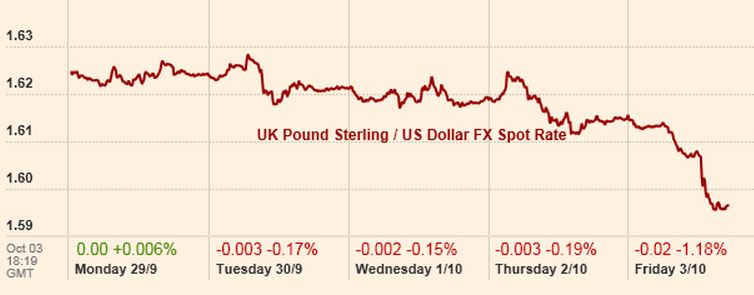US
Last week’s losses were followed by some more, as the S&P 500 lost 0.75% to close at 1967.9 and the NASDAQ Composite and DJIA went down 0.81% and 0.6% respectively from their values at the end of last week. Stocks took a beating on Tuesday and Wednesday especially as the data on consumer confidence and the ISM manufacturing PMI came out very soft and short of expectations. However, the month’s jobs report was again a surprise on the upside as 248k jobs were created in September and the unemployment rate dived under 6%, down to a level last seen six years ago. This was enough to spark a rebound in US stocks, which effectively recouped half of their weekly losses on Friday. We see the picture for the S&P 500 this week below:
Source: FT
The US yield curve continued to adjust following the signals coming from the US economy; the jobs report and the data on unemployment on Friday pushed the curve up and especially so the 2 to 10-year sector. However, save for the very short end (up to 6 months) yields are uniformly lower than last week, with the 5 to 30-year sector yielding 10 bps less. In fact, while short-term rates may well be hiked sooner than expected after the headlines on Friday, wage inflation is not picking up and last week’s data sees it even falling, the participation rate in the US economy is down to 62.7% and the 5yr-5yr inflation swap rate is at 2.15%, certainly all levels not consistent with reflationary expectations.
Inflation expectations are cooled also by the continuing rise of the dollar, which gained value against all major currencies and most notably so vis-a-vis the British pound and the euro, edging higher against the two by 1.79% and 1.32% respectively.
The most notable pieces of economic news coming out next week will be the FOMC minutes of the meeting in September 16-17, which will help assess the Fed’s policy discussion and the likely response to this week’s news.
Eurozone
This week the data investors were focusing their attention on, was the monthly inflation reading. The Data released on Thursday showed further slowdown of the inflation rate (which was anticipated by investors) from 0.4% in August to 0.3% in September, and an unexpectedly lower Core inflation (0,8% vs 0,9% expected). Stock market welcomed the news and ended the day in the green, betting on the possibility of more decisive action by the ECB.
PMI data on Wednesday surprised to the upside both in Italy and Spain whereas indicated the first contraction in 15 months for Germany.
On Thursday the Euro after the non-announcement by Draghi, pared a little the losses of the week, retracing to 1.266 against the dollar. But after better-than-expected economic data from the US, the Euro continued to lose ground against all major currencies, and in particular with the dollar it dropped as low as 1.25, to the lowest level in two years.
Source: Yahoo Finance
As a result stocks ended the week lower, with EUROSTOXX 50 losing 2.68% on the week and closing at the lowest point since August.
Italy FTSE_MIB was the real victim, leaving on the ground as much as 4% on Thursday.
Next week the release of industrial production data in Europe is going to be the key market driver.
UK
This week we witnessed again mixed data this week in UK. Manufacturing and Services PMI came slightly below expectations, while Construction PMI came above expectations. The Final GDP q/q was 0.9%, up from the expectations of 0.8%. Nationwide HPI m/m, a country measure of house prices came well below expectations. This is certainly a positive for those who fear rate hikes, though huge differences between London and the rest of UK reduce the effectiveness of this index in explaining the whole picture. Quite negative was also the worse than expected Current Account, which was £ -23.1 bln instead of the expected £-16.1 bln.
Source: FT
It has been another week characterized by a weak pound on the FX market. The Sterling lost against all major currencies, and touched an eleven months low against the dollar (mostly due to a strong dollar tough). As it has occurred over the past few months the market does not trade positive news (e.g. GDP revised upwards), but reacts quickly to negative ones (below expectations PMIs, worse than expected Current Account).
The same happened for equities, with the FTSE100 losing about 2% over the week.
Yield on 10 year Gilt closed the week down to 2.40 from 2.45 of Monday.
For what concerns politics Chancellor Osborne promised more independence to both Scotland and Municipalities, as well as new energy and banking regime for Scotland.
Next week the single most important indicator will be the Manufacturing production m/m (especially after the negative PMI). Although expectations are that both Asset Purchase Facility and the Official Bank rate will be unchanged during last committee two members (out of nine) of the MPC voted to hike interest rate against the will of Michael Carney. For this reason markets will be strictly watching this measure, even if the likelihood of a rate hike during this meeting is very low.
Sources: Financial Times, Bloomber, Businessweek, WDJ
[edmc id=1965]Download as PDF[/edmc]






1 Comment
leonardo pisano · 7 October 2014 at 19:32
Good recap. If i may suggest sth: maybe i have missed it, but i dont think i’ve seen any articles on shanghai-HK stock connect project. Thats all people talk about in asia lately. Could be interesting to write sth. Keep up the good work!